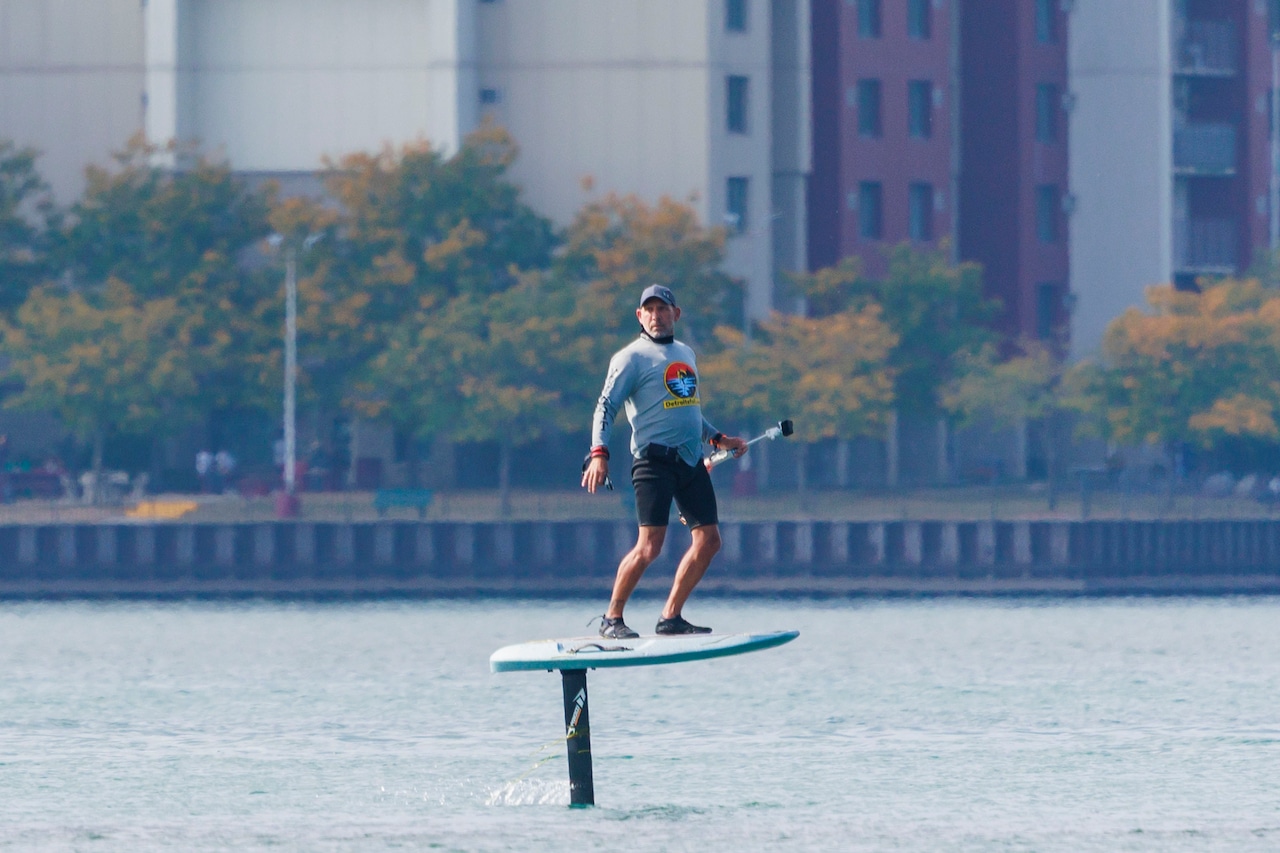
DETROIT – On a calm, rippling Detroit River, three swimmers tow a trio of boards equipped with long masts and carbon fiber wings toward a clear patch of water.
They flip the boards, climb on top, kneel, stand – and take off, rising out of the water until they’re flying along, standing on a surfboard-like platform that soars 2 feet above the waterline.
These are e-Foils, motorized surfboard-like watercraft derived from kiteboarding that allow users to travel over the water at up to 30 mph for about an hour at a time.
Detroit e-Foil was founded in 2024 by friends Tom Keda and Dewy Short, and they’re in their second season of offering lessons around Michigan. Soon, they’re opening a second location with new partners in Tawas.
Lessons start around $200 for an individual, with group discounts available. Keda, who first encountered e-Foils while instructing kiteboarding in Miami, says most customers get the hang of e-Foiling after one to two lessons.
Customer Sandi Bache, who’d booked her third lesson for that day, said she has experience with other water sports including waterskiing, and discovered the e-Foil group last summer.
She’s a frequent visitor to Detroit’s Belle Isle, and, like many others who approach Keda and Short as they prep their boards, was curious about the surfers she saw cruising the river on boards that seem to float out of the water.
“It’s harder than it looks, but when you’re out there it almost feels like you’re flying,” Bache said. “I’m definitely coming back.”
To launch, riders wade into the water, pushing the boards along turned upside-down. At about 6 feet of depth, they can flip the boards into the water and climb aboard. Small propellers on the boards move them forward; the broad “wing” provides lift for the board as it moves through the water.
Like some full-sized boats that use the same principle, the boards can move quickly because the thin mast and wing experience very little resistance as they move through the water.
“E-Foiling is a newer sport – you’re using an electric-powered surfboard with a hydrofoil on it. It helps you elevate out of the water,” Keda said. “You’re just kind of gliding above the water. It feels like, I would say, the closest thing to hoverboarding.”
The e-Foils used by Detroit e-Foil are manufactured by Waydoo, a startup company that launched a $6,000 product via Kickstarter in 2020. The lower barrier to entry has helped bring new riders to the sport, Keda said. Over time, newer, more powerful batteries and other features like extended masts and folding propellers that allow for un-powered surfing behind a boat have expanded the horizons of the sport.
“We have students take multiple lessons – I’ve had a student take 10 lessons in one season,” Keda said. “Most people take two or three, and if they end up liking it, they end up purchasing a board.”
One of the advantages of e-Foiling over kiteboarding is that it’s far less dependent on ideal weather. Where a Michigan kiteboarder might drive several hours to a beach to find the conditions aren’t right, an e-Foiler can ride on everything from still water with no wind to moderate waves, depending on the length of the board’s mast – the arm that connects the board to the underwater “wing” and propeller.
That flexibility – and the portability of the boards, which disassemble easily to fit into the trunk of a large car or SUV – makes it easier to both ride and learn.
“For kiteboarding, we’re looking for the wind to be just right,” Short said. “It makes it very hard to plan.”
Keda says new customers are encouraged to slowly acclimate themselves to the board, starting lying down, then kneeling, then standing as they learn to balance on the moving platform. Experienced foilers like Short can cruise along casually, even sitting on the front of the board and dangling their feet in the water as they skim the surface.
Beginners cruise along at up to 15 mph, but the boards are capable of going much faster . Short says he’s personally hit 28 mph in short bursts.
“It feels a lot faster than that,” he said. “It’s pretty sketchy at that speed.”
Rather than racing along the island shore, Keda and Short prefer to cruise through Belle Isle’s inlets. The near-silent foils allow riders to enjoy calm, quiet waters and surrounding nature.
Keda and Short welcome strong swimmers at any level of experience. Their clientele has ranged from a nine-person bachelor party to a surfer in his 70s and even a pro kiteboarder.
Everyone takes some time to adjust to the new sport, Keda says, but extra opportunities to practice make it easier to pick up. He considers e-Foiling much easier to learn than kiteboarding, wave boarding or non-electric foils, which require the user to hold an inflatable sail-like wings or pump their lower body to ride the surf.
The company will offer e-Foil lessons at Belle Isle, Walled Lake and other locations by appointment through the end of October – lessons will start up again in the spring, weather permitting.
“We get a lot of requests to do it here at Belle Isle, or Walled Lake, but anywhere we have lake access, we can. If you have lake access at your house, we can come to you.”
Customers can book lessons, check availability or purchase boards online at Detroit E-Foil’s website or by phone at (313) 427-9929.



